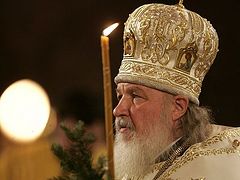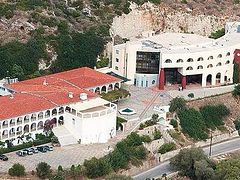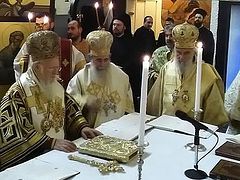Source: DECR Communication Service
January 28, 2016
Decision taken by the 5th Pan-Orthodox Pre-Council Conference, Chambésy, October 10-17, 2015
Published in compliance with the resolution of the Synaxis of Primates of the Local Orthodox Churches, Chambésy, January 21-28, 2016.
Upon completing the work based on the text “Autonomy and the Means of Proclaiming It” that had been agreed upon and adopted by the Inter-Orthodox Preparatory Commission at its session in Chambésy on December 9-17, 2009, the 5th Pan-Orthodox Pre-Council Conference considered ecclesiological, canonical and pastoral aspects of the institution of autonomy and arrived at a unanimous Pan-Orthodox position on the matter.
The issues considered by the 5th Pan-Orthodox Pre-Council Conference, derived from the topics of the text adopted by the Inter-Orthodox Preparatory Commission, relate to:
a) the concept, nature and various forms of the institution of autonomy;
b) the prerequisites, on the basis of which a local Church petitions the Autocephalous Church to which it belongs to grant it autonomy;
c) the exclusive prerogative of the Autocephalous Church to initiate and complete the process of granting autonomy to a certain part of its canonical jurisdiction, provided that no autonomous Churches shall be established in the territory of the Orthodox diaspora; and
d) the impact of this ecclesiastical act on relations of the proclaimed Autonomous Church both with the Autocephalous Church to which it belongs, and with the other Autocephalous Orthodox Churches.
1. The institution of autonomy is a canonical expression of the status of relative or partial independence that a certain ecclesiastical area has from the canonical jurisdiction of the Autocephalous Church to which it canonically belongs.
a) The application of this institution in church practice has resulted in varying degrees of dependence of an Autonomous Church upon the Autocephalous Church to which it belongs.
b) The election of the head of an Autonomous Church shall be approved or carried out by the competent ecclesiastical authority of the Autocephalous Church, the primate of which the Autonomous Church shall commemorate and be in canonical relationship to.
c) Functioning of the institution of autonomy implies that it shall be used in church practice in various forms, as defined by the degree of an Autonomous Church’s dependence on the Autocephalous Church.
d) In some forms of autonomy, the degree of dependence of an Autocephalous Church shall be expressed through its primate’s participation in the Synod of the Autocephalous Church.
2. The initiation and completion of the process of proclaiming autonomy to a part of its canonical jurisdiction, to which the Church belongs, having been proclaimed autonomous, is the canonical prerogative of the Autocephalous Church. Accordingly,
a) If a local Church requesting autonomy fulfills all necessary ecclesiastical and pastoral prerequisites, it shall appeal to the Autocephalous Church to which it belongs, explaining the serious reasons prompting such an appeal.
b) Upon receiving the appeal, the Autocephalous Church shall consider all its prerequisites and reasons, and make a decision whether or not to grant autonomy. Should the decision be favorable, the Autocephalous Church shall issue a Tomos defining the territorial boundaries of the Autonomous Church, as well as its relations with the Autocephalous Church to which it belongs, in accordance with the established criteria of ecclesiastical Tradition.
c) The primate of the Autocephalous Church shall inform the Ecumenical Patriarchate and other Autocephalous Orthodox Churches of the proclamation of the Autonomous Church.
d) The Autonomous Church maintains inter-Orthodox, inter-Christian and inter-religious relations via the Autocephalous Church that granted it autonomy.
e) Each Autocephalous Church may only grant autonomy to a Church that acts within its geographical boundaries. No Autonomous Church shall be established in the territory of the Orthodox diaspora, except by pan-Orthodox consent mediated by the Ecumenical Patriarch in accordance with pan-Orthodox procedure.
f) Should two Autocephalous Churches grant autonomous status within one and the same geographical ecclesiastical area, with resulting disagreements concerning these autonomies, the parties involved shall appeal, together or separately, to the Ecumenical Patriarch to come to a canonical solution to the question in accordance with pan-Orthodox procedure.
3. The implications arising from the proclamation of autonomy concerning the Autonomous Church and its relationship with the Autocephalous Church are as follows:
a) The head of the Autonomous Church shall only commemorate the primate of the Autocephalous Church;
b) The name of the head of the Autonomous Church shall not be included in the Diptychs;
c) The Autonomous Church shall receive Holy Chrism from the Autocephalous Church;
d) Bishops of the Autonomous Church shall be elected and appointed by its own competent ecclesiastical authority. In the event that the Autonomous Church finds this absolutely impossible, it shall receive assistance from the Autocephalous Church to which it belongs.
Chambésy, October 15, 2015





1. d) In some forms of autonomy, the degree of dependence of an Autocephalous Church shall be expressed through its primate’s participation in the Synod of the Autocephalous Church.
Best Regards.
Deborah